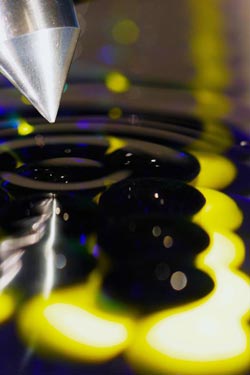Nanoscale Friction: High Energy Losses in the Vicinity of Charge Density Waves

An oscillating Atomic Force Microscope tip in proximity to the Charge Density Wave (CDW) on NbSe2 surface. The yellow and blue spheres are the Selenium and Niobium atoms forming the lattice.<br><br>University of Basel<br>
This may have practical significance in the control of nanoscale friction. The results have been published in the scientific journal Nature Materials.
Friction is often seen as an adverse phenomenon that leads to wear and causes energy loss. Conversely, however, too little friction can be a disadvantage as well – for example, running on an icy surface or driving on a wet road.
An understanding of frictional effects is therefore of great importance – particularly in the field of nanotechnology, where friction has to be controlled at a nanoscale. A recent study conducted by researchers from the University of Basel, the University of Warwick, the CNR Institute SPIN in Genoa and the International Centre for Theoretical Physics (ICTP) in Trieste has helped to give a better understanding of how friction works in microscopic dimensions.
In the experiment led by Prof. Dr. Ernst Meyer, Professor of Experimental Physics at the University of Basel, the team vibrated the nanometer-sized tip of an atomic force microscope above the surface of a layered structure of niobium and selenium atoms. They selected this combination due to its unique electronic properties, and in particular the charge-density waves formed at extremely low temperatures. The electrons are no longer evenly distributed as in a metal, but instead form areas where the electron density fluctuates between a high and low range.
Energy losses in the vicinity of charge density waves
The researchers registered very high energy losses in the vicinity of these charge density waves between the surface and the tip of the atomic force microscope, even at relatively large distances of several atomic diameters. “The energy drop was so great, it was as if the tip had suddenly been caught in a viscous fluid,” says Meyer.
The team observed this energy loss only at temperatures below 70° Kelvin (-203° C). Since charge density waves do not occur at higher temperatures, it interpreted this as evidence that frictional forces between the probe tip and charge density waves are the cause of the energy loss.
The theoretical model shows that the high energy loss results from a series of local phase shifts in the charge density waves. This newly discovered phenomenon may be of practical significance in the field of nanotechnology, particularly as the frictional effect can be modulated as a function of distance and voltage.
Original citation
Markus Langer, Marcin Kisiel, Rémy Pawlak, Franco Pellegrini, Giuseppe E. Santoro, Renato Buzio, Andrea Gerbi, Geetha Balakrishnan, Alexis Baratoff, Erio Tosatti and Ernst Meyer
Giant frictional dissipation peaks and charge-density-wave slips at the NbSe2 surface
Nature Materials, published online XXX | doi: 10.1038/NMAT3836
Further information
Prof. Dr. Ernst Meyer, University of Basel, Department of Physics, phone: +41 61 267 37 24, Email: ernst.meyer@unibas.ch
Media Contact
All latest news from the category: Physics and Astronomy
This area deals with the fundamental laws and building blocks of nature and how they interact, the properties and the behavior of matter, and research into space and time and their structures.
innovations-report provides in-depth reports and articles on subjects such as astrophysics, laser technologies, nuclear, quantum, particle and solid-state physics, nanotechnologies, planetary research and findings (Mars, Venus) and developments related to the Hubble Telescope.
Newest articles

Superradiant atoms could push the boundaries of how precisely time can be measured
Superradiant atoms can help us measure time more precisely than ever. In a new study, researchers from the University of Copenhagen present a new method for measuring the time interval,…

Ion thermoelectric conversion devices for near room temperature
The electrode sheet of the thermoelectric device consists of ionic hydrogel, which is sandwiched between the electrodes to form, and the Prussian blue on the electrode undergoes a redox reaction…

Zap Energy achieves 37-million-degree temperatures in a compact device
New publication reports record electron temperatures for a small-scale, sheared-flow-stabilized Z-pinch fusion device. In the nine decades since humans first produced fusion reactions, only a few fusion technologies have demonstrated…





















